#Philadelphia Capital of the Roman Empire
Text
Roman Theater, Souks, Eid al-Fitr Amman Jordan

View On WordPress
#Amman Citadel#Amman Farmers Market#Bedouin Craftsman#Bedouin Tents#Egyptian Pharaoh Cleopatra VII of the Ptolemaic Dynasty#Eid al-Fitr Festival of Breaking the Fast#I&039;tikaf#Jabal Al-Jofah#Jordan Folklore Museum#Jordanian Museum of Popular Traditions#Nour al Barakah#Philadelphia Capital of the Roman Empire#Ptolemy Philadelphus#Ramadan#Roman Amphitheater Amman#Roman Emperor Antoninus Pius#Roman Triumvir Mark Antony#Souk el-Khodra#Souk el-Sagha#Souk Jara#Souk Mango
0 notes
Text








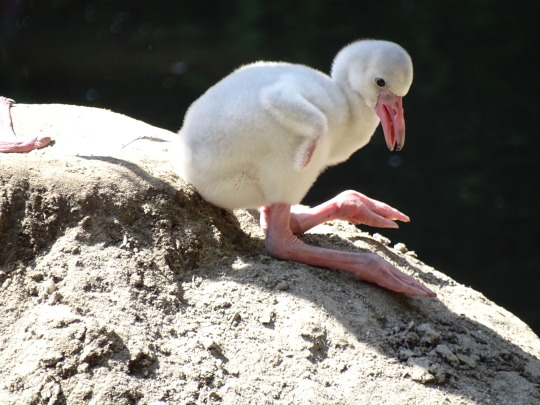








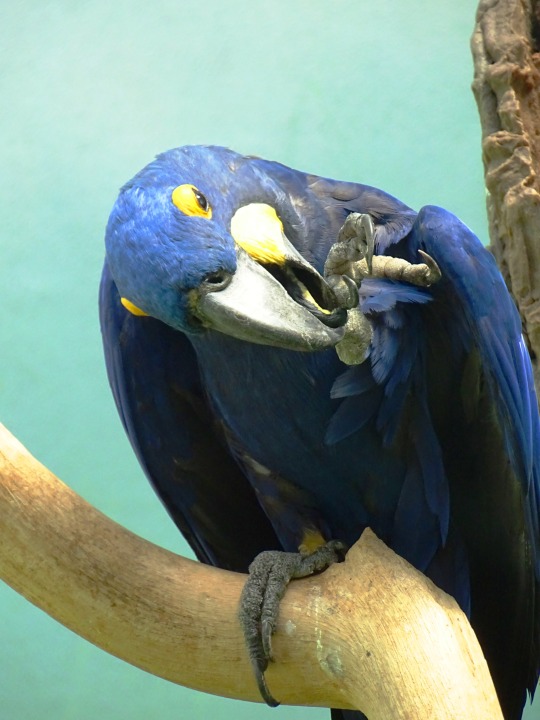



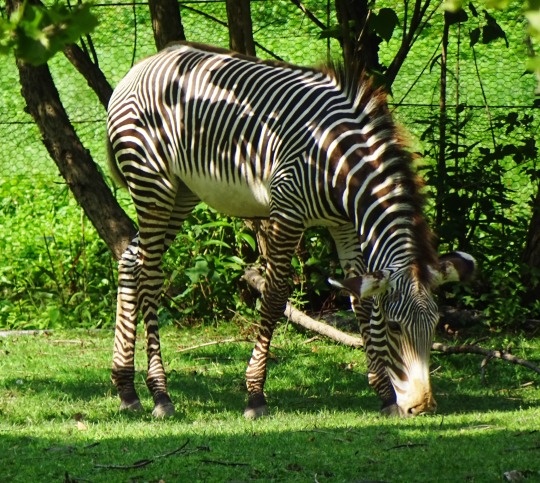






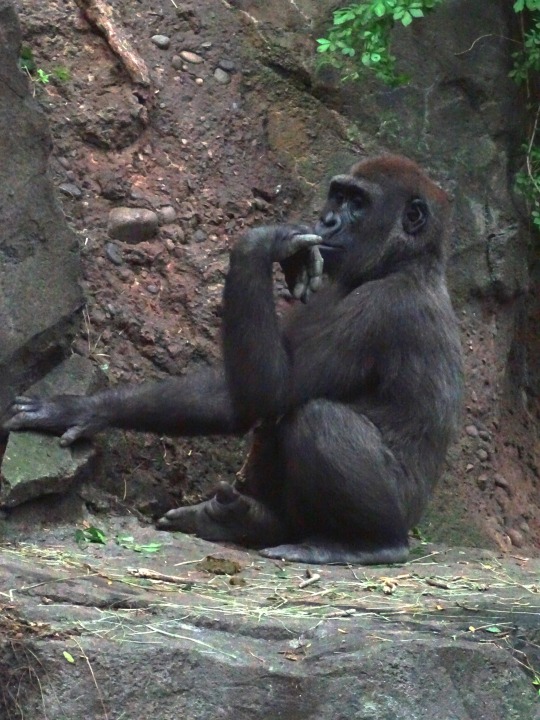

National Zoo Lovers Day
National Zoo Lovers Day, celebrated on April 8 in the U.S. brings all the zoo animal enthusiasts together to celebrate this significant day! Do you know how many animals were saved by zoos from going extinct? Yes, zoos are more than just conservation sites for endangered species, they also provide educational, research, and entertainment purposes. We can trace the history of zoos back to 4000 B.C. If you love animals, then this holiday is just for you. Visit a zoo nearby to find out about your favorite animals; you can also ask to volunteer at a zoo!
History of National Zoo Lovers Day
In the 7th century B.C, the Greeks had the habit of caging animals. ‘Alexander the Great’ sent many animals caught on his military expeditions to Greece. The earlier Egyptian and Asian zoos were kept mainly for public visitors and secondarily used for research purposes. During the 4th century B.C., the Greeks were more concerned with the research and experiment of captivated animals. The Romans had two different animal collections for arena and research objectives.
After the Roman Empire, zoos faced a downfall, but some private collections existed by Emperor Charlemagne in the eighth century and Henry I in the 12th century. King Philip VI had a menagerie in the Louvre, Paris, in 1333. Many members of the house of Bourbon had animal collections at Versailles. Later in 1519, a zoo was discovered in Mexico, which habituated birds, mammals, and reptiles. It was maintained by 300 zookeepers. In 1752, the Imperial Menagerie was founded at the Schönbrunn Palace in Vienna as the first modern-day zoo.
In 1828, two years after the Zoological Society of London was founded, the collection was created in Regent’s Park. By the mid 19th century, zoos were established worldwide. Among the existing zoos of today, more than 40 zoos are 100 years old. Most of these old zoos are in Europe. Since the end of World War II, there has been a fast and worldwide growth of zoos, many of which serve the purpose of public entertainment and economic gain rather than animal research. The exact number of public animal collections across the world today is unknown, although it is believed to be in the thousands.
National Zoo Lovers Day timeline
3500 B.C.
Hierakonpolis Zoo
The strange animal remains discovered near Hierakonpolis, Egypt's ancient capital, suggest the existence of a huge, exotic predynastic zoo.
1500 B.C.
First Real Zoo
Queen Hatshepsut establishes the first real zoo in Egypt.
30 B.C.
The Rise Of Private Zoos
From the shreds of evidence found in Egypt and Mesopotamia, private zoos show status among the wealthy in Rome.
1874
America’s First Zoo
America’s first zoo opens in Philadelphia, Pennsylvania.
National Zoo Lovers Day FAQs
Why do we need zoos?
Zoological gardens are needed to preserve biodiversity. Zoos provide a home to exotic endangered animals and have a history of saving many animals from being extinct.
Why are pet animals not allowed in the zoo?
Pet animals are not allowed in the zoo for various reasons. It can affect the health of zoo animals. Pet animals can be agitated by strange sounds, sights, and smells, which can bring out harm to anyone around.
Can I bring home the adopted animal?
Unfortunately, you cannot. The animals in the zoo cannot be brought up in a domestic household. You will be providing financial support for the animal you have adopted.
How to Celebrate National Zoo Lovers Day
Volunteer: Well, the greatest pleasure you can gain on National Zoo Lovers Day is by volunteering at a local zoo. It is a great opportunity to have a close observation of animals.
A family picnic: A great occasion to have an interesting yet informative family picnic. Take this opportunity to explore unique and exotic animals. You could also share some pictures on social media, spreading the word!
Adopt animals: Many zoos across the world provide animal adoption programs. You can show your love for conserving unique and exotic animals by adopting animals in zoos.
5 Fun Facts About Zoos That’s Sounds Too Good To Be True
Morning walks: Chendra, an Asian elephant in Oregon Zoo, likes to take a morning walk to meet her fellow zoo mates.
Entrance fee: 1/160th of a pound was charged as a zoo entrance fee at The Tower of London back in the 18th century; alternatively, visitors can also provide cats or dogs to feed the lions.
A valorous German Shepard: In 1987, a German Shepherd guard dog defeated an escaped Jaguar in Belgrade Zoo — in this valorous action, the dog saved the life of a zoo employee.
Giant pandas: China contains the ownership of all giant pandas worldwide and they are loaned to other countries at a rental price of one million dollars per pair, per year to raise funds for conservation programs in China.
Disk-throwing chimp: In Sweden, a 30-year-old chimp at Furuvik Zoo collects concrete disks to throw at the visitors.
Why We Love National Zoo Lovers Day
Fun-filled knowledge: National Zoo Lovers day reminds us to explore our local zoos. Every year, millions of people visit zoos and learn about many animals. It also provides a great opportunity for friends and families to have a fun time learning together.
Conserving the endangered: One great thing about zoos is conserving the species at the risk of extinction. An imbalance in biodiversity can bring a disastrous impact on the ecosystem. It reminds us of our responsibility towards nature.
Animal welfare: A wonderful day to remind animal enthusiasts to play their part in animal welfare. An opportunity for providing a large platform to gather support across the world.
Source
#National Zoo Lovers Day#ZooLoversDay#8 April#Bronx Zoo#vacation#my favorite zoo#New York City#summer 2018#2019#original photography#travel#animal#flora#fauna#Grizzly Bear#brown bear#Sulawesi hornbill#lion#inca tern#bald eagle#bird#nile crocodile#tiger#zebra#Silvery lutung#Mandrillus sphinx#Mandrill#close up#USA#tourist attraction
6 notes
·
View notes
Text
Events 5.25 (before 1960)
567 BC – Servius Tullius, the king of Rome, celebrates a triumph for his victory over the Etruscans.
240 BC – First recorded perihelion passage of Halley's Comet.
1085 – Alfonso VI of Castile takes Toledo, Spain, back from the Moors.
1420 – Henry the Navigator is appointed governor of the Order of Christ.
1521 – The Diet of Worms ends when Charles V, Holy Roman Emperor, issues the Edict of Worms, declaring Martin Luther an outlaw.
1644 – Ming general Wu Sangui forms an alliance with the invading Manchus and opens the gates of the Great Wall of China at Shanhaiguan pass, letting the Manchus through towards the capital Beijing.
1659 – Richard Cromwell resigns as Lord Protector of England following the restoration of the Long Parliament, beginning a second brief period of the republican government called the Commonwealth of England.
1660 – Charles II lands at Dover at the invitation of the Convention Parliament, which marks the end of the Cromwell-proclaimed Commonwealth of England, Scotland and Ireland and begins the Restoration of the British monarchy.
1738 – A treaty between Pennsylvania and Maryland ends the Conojocular War with settlement of a boundary dispute and exchange of prisoners.
1763 – First issue of Norske Intelligenz-Seddeler, the first regular Norwegian newspaper (1763–1920).
1787 – After a delay of 11 days, the United States Constitutional Convention formally convenes in Philadelphia after a quorum of seven states is secured.
1798 – United Irishmen Rebellion: Battle of Carlow begins; executions of suspected rebels at Carnew and at Dunlavin Green take place.
1809 – Chuquisaca Revolution: Patriot revolt in Chuquisaca (modern-day Sucre) against the Spanish Empire, sparking the Latin American wars of independence.
1810 – May Revolution: Citizens of Buenos Aires expel Viceroy Baltasar Hidalgo de Cisneros during the "May Week", starting the Argentine War of Independence.
1819 – The Argentine Constitution of 1819 is promulgated.
1833 – The Chilean Constitution of 1833 is promulgated.
1865 – In Mobile, Alabama, around 300 people are killed when an ordnance depot explodes.
1878 – Gilbert and Sullivan's comic opera H.M.S. Pinafore opens at the Opera Comique in London.
1895 – Playwright, poet and novelist Oscar Wilde is convicted of "committing acts of gross indecency with other male persons" and sentenced to serve two years in prison.
1895 – The Republic of Formosa is formed, with Tang Jingsong as its president.
1914 – The House of Commons of the United Kingdom passes the Home Rule Bill for devolution in Ireland.
1925 – Scopes Trial: John T. Scopes is indicted for teaching human evolution in Tennessee.
1926 – Sholom Schwartzbard assassinates Symon Petliura, the head of the government of the Ukrainian People's Republic, which is in government-in-exile in Paris.
1933 – The Walt Disney Company cartoon Three Little Pigs premieres at Radio City Music Hall, featuring the hit song "Who's Afraid of the Big Bad Wolf?"
1935 – Jesse Owens of Ohio State University breaks three world records and ties a fourth at the Big Ten Conference Track and Field Championships in Ann Arbor, Michigan.
1938 – Spanish Civil War: The bombing of Alicante kills 313 people.
1940 – World War II: The German 2nd Panzer Division captures the port of Boulogne-sur-Mer; the surrender of the last French and British troops marks the end of the Battle of Boulogne.
1946 – The parliament of Transjordan makes Abdullah I of Jordan their Emir.
1953 – Nuclear weapons testing: At the Nevada Test Site, the United States conducts its first and only nuclear artillery test.
1953 – The first public television station in the United States officially begins broadcasting as KUHT from the campus of the University of Houston.
1955 – First ascent of Mount Kangchenjunga: On the British Kangchenjunga expedition led by Charles Evans, Joe Brown and George Band reach the summit of the third-highest mountain in the world (8,586 meters); Norman Hardie and Tony Streather join them the following day.
0 notes
Text
History
May 29, 1453 - The city of Constantinople was captured by the Turks, who renamed it Istanbul. This marked the end of the Byzantine Empire as Istanbul became the capital of the Ottoman Empire.
May 29, 1660 - The English monarchy was restored with Charles II on the throne after several years of a Commonwealth under Lord Protector Oliver Cromwell.
May 29, 1787 - At the Constitutional Convention in Philadelphia the Virginia Plan was proposed calling for a new government consisting of a legislature with two houses, an executive chosen by the legislature and a judicial branch.
May 29, 1865 - Following the American Civil War, President Andrew Johnson issued a proclamation granting general amnesty to Confederates. The amnesty excluded high ranking Confederates and large property owners, who had to apply individually to the President for a pardon. Following an oath of allegiance, all former property rights, except slaves, were returned to the former owners.
Birthday - American revolutionary leader Patrick Henry (1736-1799) was born in Studley, Virginia. He is best remembered for his speech in 1775 declaring: "I know not what course others may take, but as for me, give me liberty or give me death."
Birthday - German historian Oswald Spengler (1880-1936) was born in Blankenburg-am-Harz, Germany. He authored the influential book The Decline of the West which argued that civilizations rise and fall in regular cycles.
Birthday - John Fitzgerald Kennedy (1917-1963) the 35th U.S. President was born in Brookline, Massachusetts. He was the youngest man ever elected to the presidency and the first Roman Catholic. He was assassinated in Dallas, November 22, 1963, the fourth President to killed by an assassin.
0 notes
Video
youtube
Amazing Historical Events That Occurred on 5/11 🎉 #shorts #history
Are you curious about what happened on May 11th throughout history? Join us on a journey through time as we explore some of the most amazing historical events that occurred on this day.In the year 330, a momentous occasion took place as the newly built city of Constantinople was declared the capital of the Eastern Roman Empire. This significant event marked the beginning of a new era, as Constantinople became the center of trade, culture, and politics in the region.
Fast forward to the eventful day of 1189, and we witness Holy Roman Emperor Frederick I Barbarossa setting off from Regensburg with 100,000 crusaders for the Third Crusade. This was a significant military campaign that aimed to recapture Jerusalem from the Muslim forces, and it had a profound impact on the relationship between the Christian and Muslim worlds for centuries to come.
In the year 1647, another crucial moment in history took place as Peter Stuyvesant arrived in New Amsterdam. This marked a significant period in the city's history as it became the center of trade and commerce in the region, laying the foundation for what would eventually become New York City.
Moving on to the year 1751, we see the establishment of Pennsylvania Hospital in Philadelphia, founded by Dr. Thomas Bond and Benjamin Franklin. This was the very first hospital in the United States and marked a significant milestone in the development of healthcare in the country.
Finally, in 1812, British Prime Minister Spencer Perceval was assassinated by John Bellingham in the lobby of the House of Commons. This shocking event created a shockwave in the political landscape of that time, as it was the first time a British Prime Minister had been assassinated in office.
These amazing historical events that occurred on May 11th have had a significant impact on the world as we know it, shaping our culture, politics, and society in numerous ways. Join us as we delve deeper into these events and explore their lasting effects on our world today.
0 notes
Text
Amman Jordan
My free day in Amman didn't go as originally planned. I neglected to check the calendar and it was Eid, the last day of Ramadan. It's a big holiday, so most things were closed, including the Jordan Museum. The town was very quiet in the morning but in the evening it was very busy. On the last day of fasting, at sundown, the restaurants and cafes were crowded.
The Roman and Arab Citadel is located directly above my hotel. It was open, so I headed up there. There are stairways up the hill, but some only go to private houses and Google Maps didn't seem to understand them, so my route up took a long way, mostly up the streets, except for a promising stair that took me part of the way up.
Jordan is one of the oldest cities in the world, with artifacts dating from 8,000 BC. The Citadel, at the high point, has been occupied for most of that time. During the iron age it was the capital of the Ammonite kingdom and was known as Rabat Aman. In the 3rd Century BC, it was conquered by Ptolemy II Philadelphus, Pharaoh of Egypt. He renamed it Philadelphia, although it's not the famous Philadelphia, that one is in Turkey. During Roman rule, it was one of the 10 cities of the Decapolis. In the 7th Century the Arabs conquered it from the Byzantines and restored the name Amman. Starting in the Middle Ages the city varied from prosperous to almost abandoned. From the 1500s to 1878 it was only a small village. At that time the Ottoman Empire made it a local capital and it grew swiftly from a population of a few thousand to over 4 million.
Before heading up I stopped off at the Roman Theater across the street. It's built into the valley wall and it is in good enough shape that it is still used.

Next to it is a small Roman theater. It probably originally had a roof and have may have been used as a parliament.

Then it was up the hill. The Citadel has a 360 view of the surrounding part of Amman. This is just halfway around!
The Theater was directly below and my hotel is on the left edge of the photo.

There are the typical Roman temples, but nothing from earlier periods. The Romans clearly cleaned off the hilltop and started fresh on their construction.

This is believed to be a temple to Hercules based on the parts of a huge statue nearby.

While the new museum in the valley was closed the smaller one in the site was open and had the most interesting things, some of the oldest human statues in the world from 8,000 BC.

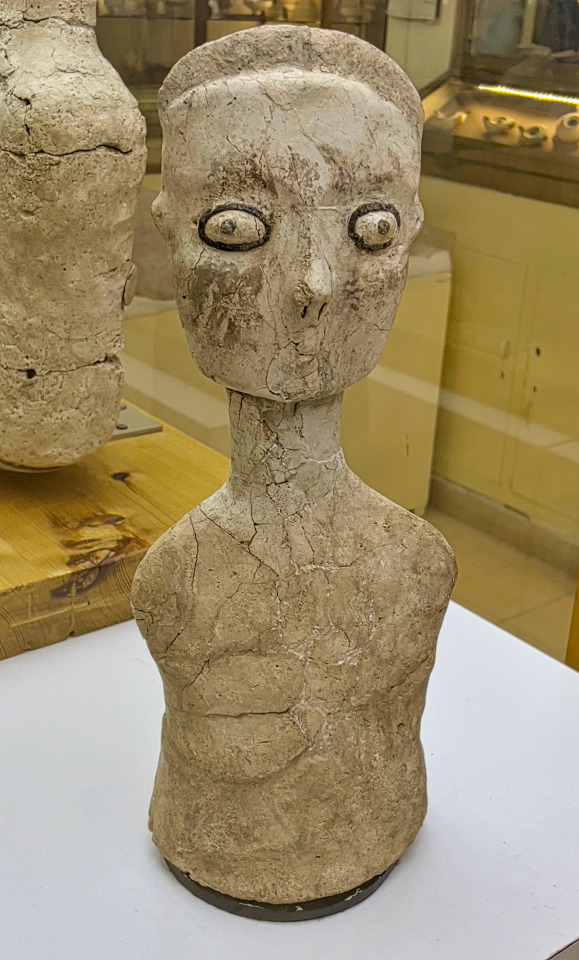
The Arabs also built here, including a large palace. Only the entry hall remains standing, but it is an impressive foyer.


There are a huge number of stray cats in Amman. As the lady a the front desk of the hotel said, they are pretty quiet until February then they are very noisy and then there are new kittens in the spring. These two were just outside the door of the hotel and looked healthier than most.
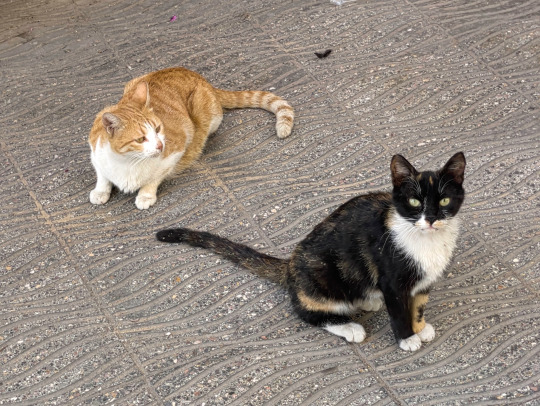
In the markets, I saw a lot of these fruits that I didn't recognize.


Here they are called azkadenya, but we know them as loquats. They are very sweet, similar to a very ripe pear. They are also as tender as a very ripe pear, so wouldn't travel well. I won't look for them in Madison any time soon.
Today I'm checking out of my hotel and transferring to the hotel for the first night of the group tour. Tomorrow we head right out to the Dana Biosphere Reserve, where the hiking begins.
0 notes
Text
Austrian Wine
https://j.mp/3joaM3C
Austria is well known for Mozart, Schnitzel, Sacher torte, and The Sound of Music, but are you aware of its viticulture? During the 19th century, Austria’s wine industry boomed, but many setbacks in the 20th century almost eradicated it. But, like the phoenix from the ashes, it has reemerged riding on the back of its unique and popular grape: Gruner Veltliner. Over the last decade, wines produced from Zweigelt and Blaufrankisch have started to make waves in the United States, bolstering Austria’s place in viticulture. But, to take a closer look, we need to start at the beginning: a perfect place to start. Table of ContentsHistory of Austrian WinePhylloxeraEthylene GlycolRenewalWine todayWine RegionsNiederosterreichBurgenlandSteiermarkViennaVarietalsGruner VeltlinerWiener Gemischter SatzZweigeltBlaufrankischSt. LaurentAustrian Wine Regions History of Austrian Wine Wine came to Austria via the Celts in 700 BCE. The Romans further advanced winemaking in the first century BCE by improving production techniques. After the fall of the Roman Empire, however, winemaking stagnated. In the 9th century, Charlemagne encouraged winemaking and instituted new guidelines. Cistercian Monks further advanced wine production by introducing Burgundian methods in the dark ages, and by the 15th century, vineyards covered most regions of Austria. Phylloxera Austrian winemaking continued to thrive until the late 1800’s when mildew and phylloxera devastated the vines throughout the country. The further decline occurred after World War I and the collapse of the Habsburg Monarchy when 30% of Austrian vines were lost when portions of Austria were annexed to other countries. The Soviets further plundered winemaking with the collapse of Nazi Germany after World War II. As a result, the wine industry started making low-quality, mass-produced wine after WW2. Ethylene Glycol The greatest embarrassment to Austrian wine culture occurred in the mid-1980s when it was found that some winemakers added ethylene glycol to their wines to increase their complexity. As a result, the Austrian industry fell into shambles, and exports dropped substantially. Renewal So, how do you solve a problem like a bad reputation? In 1986, the Austrian Wine Marketing Board was established. After that, strict wine laws were increasingly put in place, culminating in 2009 with the passage of the Austrian Wine Act. The government-guaranteed wine regulation and quality, and Austrian wines were well on their way back. Let’s take a closer look at Austrian wine today. Wine today Austrian wine is now synonymous with Gruner Veltliner, their native grape. This grape represents their most planted and exported wine. It remains the anchor of Austrian wine; however, sales of Gruner have grown stagnant. New and interesting red wines made from Zweigelt and Blaufrankisch receive rave reviews and may indicate the start of the second wave of exports from Austria. Let’s dive further into this beautiful country and the grapes they use. Wine Regions The land of Austria involves thoughts of the Alps and great skiing (primarily in the western part of the country). Austria’s east and south regions are perfect for Vitis vinifera and are where most of the country’s wine is produced. Niederosterreich Austria’s largest wine region is Niederosterreich, located in the northeast part of the country. This area lies along the Danube and contains the capital city, Vienna. It is the heart of white wine production, mainly Gruner Veltliner comprising 44% of the planted grapes. Eight specific DAC (Districtus Austriae Controllatus) are located in this region. Six of the 8 DAC focus on white wine: Wagram, Traisental, Wachau, Kremstal, Kamptal, and Weinviertel. These regions focus not only on the outstanding Gruner Veltliner but other white grapes, including Riesling, Pinot Blanc, and Chardonnay. In addition, reds rule in the southern regions of Carnuntum and Thermenregion. Burgenland South of Niederosterreich is Burgenland, where the red wines from Blaufrankisch, St. Laurent, and Zweigelt reign supreme. Five DAC exists in this region. The DAC of Mittelburgenland leads to full bodied dark fruit driven reds while the DAC of Neusiedlersee, Leithaberg, and Eisenberg produce more minerally and tannic wines. Within Neusiedlersee lies the special region of Seewinkel. This region has a unique humid microclimate due to its proximity to Lake Neusiedle, which leads to the development of botrytis on the grapes in the region. Called noble rot, grapes affected develop high sugar levels and give rise to the production of quality dessert wines called Ausbruch. The 5th DAC called Rosalia is aptly named given its production of rose wines. Steiermark Located just southwest of Burgenland is Steiermark (Styria) which contains 3 DAC. Vulkanland Steirmark makes spicy white wines due to its volcanic soils. (May this region live long and prosper)! Sudsteiermark is known for its Sauvignon Blanc production and Weststeiermark makes red wines from Blauer Wildbacher. Vienna As the only country capital in the world that makes high-quality wines, Vienna is known for its table wine called Wiener Gemischter Satz: a field blend of white grapes. Now that we discussed the regions let’s take a closer look into the unique grapes from Austria. Varietals Gruner Veltliner Gruner Veltliner makes the most important wine in Austria and accounts for 31% of all grapes planted in the country. This grape is believed to come from a crossing between Traminer and another unconfirmed 2nd grape. The grape is easily grown throughout the Niederosterreich and is regulated by the Austrian government to limit production and maintain quality. The Gruner grown in the region of Weinviertel are the most well-known and are of the highest quality. These wines are the spiciest and peppery, along with higher acidity than other Gruners. Gruner made in the rest of the Niederosterreich is generally riper with stone fruit notes and a bigger body. Wiener Gemischter Satz Wiener Gemischter Satz is a field blend grown in Vienna and is served in every tavern across the city as a table wine. It is made from many varietals, including Gruner Veltliner, Riesling, Traminer, and other whites. Recently, this blend has been produced for exportation, and this wine may be found in the US in the future. Other white wine varietals planted throughout Austria but mainly in the Niederosterreich and Steiermark are the international grapes Riesling, Pinot Blanc, Sauvignon Blanc, and Chardonnay. Zweigelt Red grapes are mainly grown in the lower Niederosterreich, throughout the Burgenland, and in the Steiermark. The Zweigelt grape was created in the 1920s by Professor Fritz Zweigelt when he crossed Blaufrankisch and St. Laurent. Zweigelt is the most widespread red grape in Austria, accounting for 14% of grapes planted. It is mainly grown in Burgenland. Wines produced from this grape are usually well structured and balanced with dark fruit notes. Consequently, these wines are sometimes compared to pinot noir. Blaufrankisch Blaufrankisch is a traditional Austrian grape mainly grown in Burgenland and southern Niederosterreich. This grape accounts for 6.5% of all vines in the country. It was first known to be produced in the 1700s and tends to make wines with high acidity and tannins characterized with cherry or berry notes. St. Laurent The additional red grape, St. Laurent, was named for St. Lawrence day, the day that grapes begin to change color. Wines made from this grape are usually dark and big-bodied with cherry notes. The final red grape, Blauer Wildbacher, is closely related to Blaufrankisch and usually made into rose wines called Schilcher-the signature wine in the Weststeiermark. Austrian Wine Regions As you can see, outstanding wines are being made in Austria from unique grapes that grow very well throughout the country. Furthermore, Austria’s wine industry is well-regulated and guarantees that wines made here are of high quality. As always, it is also important for the wines to be delicious, and as you explore them, you will agree that they truly are! So before I say so long, farewell, Auf Wiedersehen, goodbye, you should get your Schnitzel, play a little night music, and enjoy some truly fantastic Austrian wines. Imagine finishing your night with a Sacher torte, watching the sound of music, and enjoying amazing Ausbruch. You will agree with me that the Austrian hills are truly alive with the sound of viticulture! Wine Courses L1 Online Wine Certification Core (L2/L3) wine Courses Advanced (L4) wine Programs Wine Region Articles Major Wine Regions Wine Regions of the World Italian Wine Regions Spanish Wine Regions Portuguese Wine Regions East Coast Wine Regions The Best East Coast Wineries Terroir of East Coast Wines Best Wineries Near Philadelphia International Wine Regions Austrian Wine REgions Israeli Wine Regions Beaujolais Turkish Wine Regions Swiss Wine Regions Texas Hill Country Vinho Verde The Story of Champagne By Keith Wallace https://j.mp/3joaM3C
1 note
·
View note
Photo










TOGATE VICTORIANS
Lawrence Alma-Tadema’s depictions of everyday life in ancient Rome were meticulously researched at Pompeii, Herculaneum, and the archæological museum in Naples. Unlike the die-hard Neo-classicists who attempted to recreate the style and technique of Roman wall paintings, Alma-Tadema renders his accurately-observed ancient objects in a slick, aggressively modern style. His most effective pictorial device–the quasi-photographic cropping of scenes to suggest an accidental glimpse of an unguarded moment—is his least ancient.
Alma-Tadema was not an antiquarian concerned with preservation of the past. He was fascinated by what he felt to be the modernity of the Romans, and his paintings were designed to demonstrate how much the Roman and British Empires had in common. Nor are his works the visual equivalent of the historical novel. The Renaissance Florentines of George Eliot’s Romola (1863) have been criticized for being too historically accurate–mere scaffolding for the display of the author’s vast erudition. Alma-Tadema’s images of pallid maidens performing courting, reading, waiting, refraining, and renouncing have the opposite problem–they are Roman in kit and gear only (Trollope would have envied titles like Ask Me No More, Unwelcome Confidences, No Sir I Don’t! She Said, and, A Foregone Conclusion).
Even the historical Romans who occasionally process through his paintings are much more tea and cricket than bread and circus. Paintings of perversely-obscure historical incidents like The Roses of Elagabalus seem to have been chosen purely to capitalize on the very Victorian fad for fin-de-siècle, “decadence” and sexual ambiguity.
Reducing the Romans to togate Victorians was not a careless error, of course. Alma-Tadema’s pictures of antiquity are not historical, they are allegorical. The Roman past, seen in his work, is a proxy for the British present, wherein unmentionable topics like colonialism, gender, class and sexuality can be addressed indirectly. This type of painting—discursive, often 9 feet in length—recalls early computers that took up whole rooms to accomplish operations that are done today much more efficiently in the palm of one’s hand. They became obsolete “in or about June of 1910,” as Virginia Woolf put it, precisely at the moment when those topics could be addressed openly.
#victorian painting#lawrence alma-tadema#frederic leighton#royal academy#historicism#george eliot#tennyson
79 notes
·
View notes
Text
JORDAN 🇯🇴
Strange, haunting beauty and a sense of timelessness. Dotted with the ruins of empires once great, it is the last resort of yesterday in the world of tomorrow.
— The late King Hussein
One of the most beautiful countries I've ever seen. Why? Because of people. Jordan people really made my trip here.
Now I'm gonna give you some tips for visiting Jordan in 9 days.
- do not use public transports (they don't work properly); better to go around with a driver or rent a car (as we did: we payed 200JD for 8 days)
- atm can be found easily everywhere
- remember always to have water with you (first of all in the hot season) and something to cover your shulders/head.
- people are super kind and I've always trusted them. Don't be shy and get to know locals! ☺️
Day 1 - Amman
We arrived in Amman and we went immediately sleeping, as it was 4AM. The day after, we woke up and went directly visiting the city.
What to see:
1) CITADEL
The area known as the Citadel sits on the highest hill in Amman, Jebel Al Qala’a (about 850m above sea level), and is the site of ancient Rabbath-Ammon. Occupied since the Bronze Age, it's surrounded by a 1700m-long wall, which was rebuilt many times during the Bronze and Iron Ages, as well as the Roman, Byzantine and Umayyad periods. There's plenty to see, but the Citadel's most striking sights are the Temple of Hercules and the Ummayad Palace.
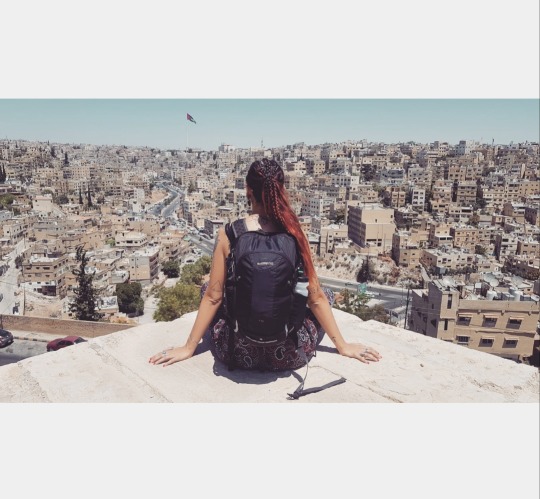
2) ROMAN THEATRE
This magnificently restored theatre is the most obvious and impressive remnant of Roman Philadelphia, and is the highlight of Amman for most foreign visitors. The theatre itself is cut into the northern side of a hill, and has a seating capacity of 6000. The best time for photographs is the morning, when the light is soft – although the views from the top tiers just before sunset are also superb.
3) SUQ
Bustling markets and souqs brimming with treasured lamps and magic carpets have long been a rather stereotypical, largely orientalist image associated with the ‘Eastern World’. In reality, that Middle East mall culture is where its at, but in recent years a number of very innovative and groundbreaking markets have also cropped up in and around Amman. Just walk inside them, feel the atmosphere and all the smells around.
4) KING ABDULLAH MOSQUE
Completed in 1989 as a memorial by the late King Hussein to his grandfather, this blue-domed landmark can house up to 7000 worshippers, with a further 3000 in the courtyard. There is also a small women’s section for 500 worshippers and a much smaller royal enclosure. The cavernous, octagonal prayer hall is capped by a magnificent blue dome 35m in diameter, decorated with Quranic inscriptions. This is the only mosque in Amman that openly welcomes non-Muslim visitors.
Where to eat
- Al Quds
We'll happily vote for this tiny, spotlessly clean place on Rainbow St as one of the best falafel spots in Amman. Tasty sandwiches (with tomato and pickles) have been served up fast for more than 50 years, but watch out for lunchtime queues when the office workers descend.
And for have some drinks go to La Calle, one of the few proper drinking holes on Rainbow St, La Calle has a couple of decent-sized bar areas, and a small but breezy terrace on the 3rd floor that's great for cooling off with a glass of wine or a chilled bottle of local Carakale ale.
We slept at Olive Hotel, very cheap and located in the city center.
Day 2 - Jerash & Mount Nebo
From Amman you can easily get a car and drive to Jerash. It should take 1 hour but it depends a lot on the traffic.
The ruined city of Jerash is Jordan's largest and most interesting Roman site, and a major tourist drawcard. Its imposing ceremonial gates, colonnaded avenues, temples and theatres all speak to the time when this was an important imperial centre. Even the most casual fan of archaeology will enjoy a half-day at the site – but take a hat and sunscreen in the warmer months, as the exposed ruins can be very hot to explore.
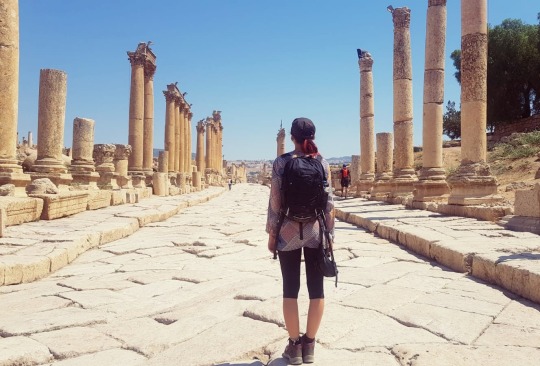
From there we drove South to Mount Nebo.
MOUNT NEBO is where Moses is said to have seen the Promised Land, a land he was himself forbidden to enter. It's believed that he died aged 120 and was later buried in the area, although the exact location of the burial site is the subject of conjecture.
After hiking on Mount Nebo, we drove to Madaba where we slept for two nights.
MADABA, 33 km (20 miles) south of Amman, is known as The City of Mosaics where underneath almost every house lies a fine Byzantine mosaic, with its long history dating back further than 1300 BC. Here we visited the biggest mosaic center of the world.
Best restaurant: Adonis
Best hotel: Grand Hotel Madaba - staff is super friendly and helped us a lot!
Day 3- Azraq and the East Desert
Stretching east of Amman, the parched desert plain rolls on to Iraq and Saudi Arabia. This is a place where endless sand and barren basalt landscapes give proof to man’s ability to thrive under harsh conditions. The discovery of flint hand-axes in this desert indicates that Paleolithic settlers inhabited the region around half a million years ago. But the most remarkable remains of human habitation are the palaces built by the Damascus-based Umayyad caliphs during the early days of Islam (seventh-eighth centuries CE). During the height of the Umayyad dynasty, architecture flourished with the cultural exchange that accompanied growing trade routes. By 750 CE, when the Umayyad dynasty was overthrown by the Abbasids of Baghdad, a richly characteristic Muslim architecture was evolving, owing considerably to the cosmopolitan influence of builders and craftsmen drawn from Egypt, Mesopotamia and elsewhere throughout the region.
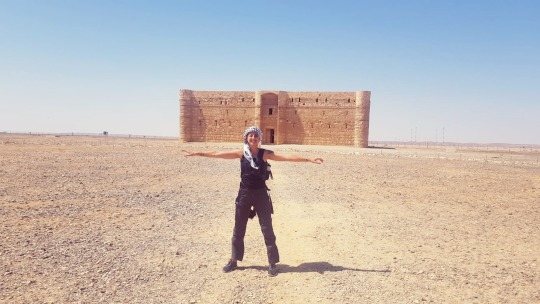
Today it is possible to see many relics of the early and medieval Islamic periods in Jordan. Dotted throughout the steppe-like terrain of eastern Jordan and the central hills are numerous historic ruins, including castles, forts, towers, baths, caravan inns and fortified palaces. Known collectively as the desert castles or desert palaces, they were originally part of a chain stretching from north of Damascus down to Khirbet al-Mafjar, near Ariha (or Jericho).
There are various theories about the purpose of the desert palaces, yet the lack of a defensive architectural design suggests that most were built as recreational retreats. The early Arab rulers' love of the desert led them to build or take over these castles, which appear to have been surrounded by artificial oases with fruit, vegetables and animals for hunting. Other theories suggest that they came to the desert to avoid epidemics which plagued the big cities, or to maintain links with their fellow Bedouin, the bedrock of their power.
Most of the desert castles can be visited over the course of a day in a loop from Amman via Azraq. The following description details a road trip taking the northern route from Amman to Azraq and the southern highway on the return trip.
What to see:
- Qsar Al-Azraq
- Azraq natural reserve
- Qusayr Amra
- Qasr Kharana
Day 4- Wadi Mujib and the Dead Sea
From Madaba we started driving south, direction Dead Sea.
A spectacular natural wonder the Dead Sea is perfect for religious tourism and fun in the sun with the family. With its mix of beach living and religious history you can soak up the sun while Biblical scholars can get their daily dose of religious history. The leading attraction at the Dead Sea is the warm, soothing, super salty water itself – some ten times saltier than sea water, and rich in chloride salts of magnesium, sodium, potassium, bromine and several others. The unusually warm, incredibly buoyant and mineral-rich waters have attracted visitors since ancient times, including King Herod the Great and the beautiful Egyptian Queen, Cleopatra. All of whom have luxuriated in the Dead Sea's rich, black, stimulating mud and floated effortlessly on their backs while soaking up the water's healthy minerals along with the gently diffused rays of the Jordanian sun.
First stop was the Dead Sea Panoramic Complex, for an amazing view on the Dead Sea. Them we drove to the Wadi Mujib Adventure Center. This is a must-do in your trip! A beautiful adventure in the Canyon 😍

After this 2-hours adventure we started driving south on the Kings Highway, stopping by a couple of castles:
- Karak castle
- Shobak castle
Day 5- Petra

Undoubtedly the most famous attraction in Jordan is the Nabatean city of Petra, nestled away in the mountains south of the Dead Sea. Petra, which means "stone" in Greek, is perhaps the most spectacular ancient city remaining in the modern world, and certainly a must-see for visitors to Jordan and the Middle East. The city was the capital of the Nabateans -Arabs who dominated the lands of Jordan during pre-Roman times- and they carved this wonderland of temples, tombs and elaborate buildings out of solid rock. Every year thousands of people flock to one of the main places to visit in Petra, the monasteries excavated in rock. In two days you can enjoy the 15 kilometer long route. To begin, it would be nice for you to see the main Petra attractions: the Visitor Center, the Via Sacra or Al-Khaznez. The architectural beauty is priceless, for it has been featured in many films, as might be Indiana Jones. Ad-Deir Monastery offers a spectacular view and is one of the most famous monuments and attractions in Petra. An area and 800 steps separate you from this natural treasure. The Theatre of the Nabataeans acts as a chameleon in the desert, carved directly into the rock. Other stuff to do in Petra includes visiting the Altar of Sacrifice, one of the best viewpoints that can be enjoyed throughout the country. Between monument and monument, you'll be transported through the Avenue of the columns, a very busy road with a series of Doric columns that look like decorated stone. It's one of the most charming things to see in Petra. Finally, here at Minube we encourage you to complement these Petra activities by visiting the Royal Tombs. They're visible from anywhere in the area. Certainly, Petra could be part of the seven wonders of the world, since many people request information about the many places to see in Petra. Go and find out for yourself!
Tickets for one day cost 50JD; for 2 days is 55JD. As it's huge, better to get the 2-days-tickets!
Restaurants: Red Cave (beduin meals) and Beit Al Barakah
We stayed at Al Rashid hotel that is located in the very city center.
Day 6- Petra
As Petra is huge, we visited the city for 2 days. In the afternoon we took the car and drove to Aqaba.
Day 7/8 - Aqaba
In summer here the weather is really, really hot! Too hot 😥 it's difficult to walk around and do things. You absolutely need to stay at the beach for cooling down.
We stayed at Aqaba Adventure Center. It's a sort of hostel with a pool, and it's a diving center too. It's 10km from Aqaba, but with the car was perfect to go and back.
Aqaba is Jordan's only Red Sea resort and port city which is warm, sunny, inviting, and has a dazzling undersea world of some of the most spectacular coral reefs to be found anywhere else, located 332 km (206 miles) south of Amman. For relaxation, water sports, and winter warmth, Aqaba is warm, sunny and inviting, fringed with palm trees, lapped by the crystal clear waters of the Gulf of Aqaba, cooled by a steady northerly breeze, and ringed by mountains that change in color with the change of the hours. Snorkeling, water skiing, wind surfing, para-sailing, fishing and a variety of other water sports, including unsurpassed scuba diving are just some of the popular activities to partake in. It's very turistico and not like the other places we visited in Jordan, but it worths for relax and snorkeling 🌊🦐🦀🐠🐙🐡
Best restaurants: Ali Baba Restaurant and Captain's restaurant (for fish)
You can find also places that serve alcool here (we really love the staff at Buffalo Wings!)
Day 9 - Wadi Rum
Wadi Rum is everything you’d expect of a quintessential desert: it is extreme in summer heat and winter cold; it is violent and moody as the sun slices through chiselled siqs (canyons) at dawn or melts the division between rock and sand at dusk; it is exacting on the Bedouin who live in it and vengeful on those who ignore its dangers. For most visitors, on half- or full-day trips from Aqaba or Petra, Wadi Rum offers one of the easiest and safest glimpses of the desert in the region. For the lucky few who can afford a day or two in their itinerary to sleep over at one of the desert camps, it can be an unforgettable way of stripping the soul back to basics.

We stayed at Beduin Lifestyle Camp and we are really satisfied of this beautiful experience. We had a 4 hours tour on the Jeep during the afternoon, where we could see all the most beautiful places in the Wadi Rum. We watched the sunset drinking tea with our Beduin friend and then we slept in a Beduin camp. In the evening we had dinner with them and played music together, dancing. We slept in a very small tent, but it was clean and comfi. The day after we took the camel for going back to the village.

Day 10 - back to Amman
400km back to Amman, a long drive before flying back home.
Special memories to those people we met during this wild adventure:
- Mohammad (met in a shop in Amman)
- the small child and his dad offering us tea in Azraq
- Abdullah (the beduin near Azraq)
- Marta and Niccoló, who did Canyoning with us
- Maria and Bernart, the two Spanish guys who hiked with us in Petra
- Saker, the Jordan guy met in sport bar in Petra who gave us camel milk
- Steffi and JoJo, the two German girls from Munich
- Harm, the musician Beduin who cooked tea for us in the Wadi Rum
Thanks to my travelmates who came with me during this amazing adventure...
2 notes
·
View notes
Photo
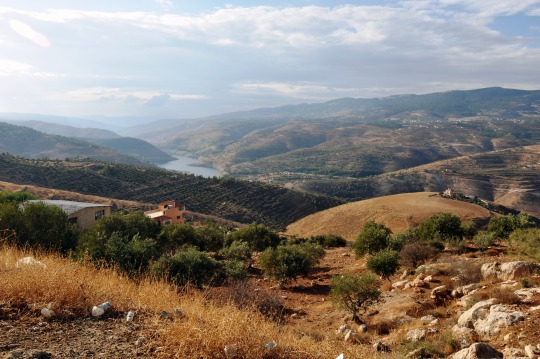
Jordan, Arab country of Southwest Asia, in the rocky desert of the northern Arabian Peninsula. It is a young state that occupies an ancient land, one that bears the traces of many civilizations. Separated from ancient Palestine by the Jordan River, the region played a prominent role in biblical history. The ancient biblical kingdoms of Moab, Gilead, and Edom lie within its borders, as does the famed red stone city of Petra, the capital of the Nabatean kingdom and of the Roman province of Arabia Petraea. British traveler Gertrude Bell said of Petra, “It is like a fairy tale city, all pink and wonderful.” Part of the Ottoman Empire until 1918 and later a mandate of the United Kingdom, Jordan has been an independent kingdom since 1946. It is among the most politically liberal countries of the Arab world, and, although it shares in the troubles affecting the region, its rulers have expressed a commitment to maintaining peace and stability.
The capital and largest city in the country is Amman—named for the Ammonites, who made the city their capital in the 13th century BCE. Amman was later a great city of Middle Eastern antiquity, Philadelphia, of the Roman Decapolis, and now serves as one of the region’s principal commercial and transportation centres as well as one of the Arab world’s major cultural capitals.
Although Jordan’s economy is relatively small and faces numerous obstacles, it is comparatively well diversified. Trade and finance combined account for nearly one-third of Jordan’s gross domestic product (GDP); transportation and communication, public utilities, and construction represent one-fifth of total GDP, and mining and manufacturing constitute nearly that proportion. Remittances from Jordanians working abroad are a major source of foreign exchange.
However, although Jordan’s economy is ostensibly based on private enterprise, services—particularly government spending—account for about one-fourth of GDP and employ roughly one-third of the workforce. In addition, Jordan has increasingly been plagued by recession, debt, and unemployment since the mid-1990s, and the small size of the Jordanian market, fluctuations in agricultural production, a lack of capital, and the presence of large numbers of refugees have made it necessary for Jordan to continue to seek foreign aid. The Jordanian government has been slow to implement privatization. Despite efforts by the International Monetary Fund (IMF) and the World Bank to boost the private sector—including agreements to write off the country’s external debt and loans from the World Bank designed to revitalize Jordan’s economy—it was only in 1999 that the government began introducing a number of economic reforms. These efforts included Jordan’s entry into the World Trade Organization (in 2000) and the partial privatization of some state-owned enterprises.
Only a tiny fraction of Jordan’s land is arable, and the country imports some foodstuffs to meet its needs. Wheat and barley are the main crops of the rain-fed uplands, and irrigated land in the Jordan Valley produces citrus and other fruits, potatoes, vegetables (tomatoes and cucumbers), and olives. Pastureland is limited; although artesian wells have been dug to increase its area, much former pasture area has been turned over to the cultivation of olive and fruit trees, and large areas have been degraded to the point that they can barely support livestock. Sheep and goats are the most important livestock, but there are also some cattle, camels, horses, donkeys, and mules. Poultry is also kept.
Mineral resources include large deposits of phosphates, potash, limestone, and marble, as well as dolomite, kaolin, and salt. More recently discovered minerals include barite (the principal ore of the metallic element barium), quartzite, gypsum (used as a fertilizer), and feldspar, and there are unexploited deposits of copper, uranium, and shale oil. Although the country has no significant oil deposits, modest reserves of natural gas are located in its eastern desert. In 2003 the first section of a new pipeline from Egypt began delivering natural gas to Al-ʿAqabah.
Virtually all electric power in Jordan is generated by thermal plants, most of which are oil-fired. The major power stations are linked by a transmission system. By the early 21st century the government had completed a program to link the major cities and towns by a countrywide grid.
Beginning in the final decades of the 20th century, access to water became a major problem for Jordan—as well as a point of conflict among states in the region—as overuse of the Jordan River (and its tributary, the Yarmūk River) and excessive tapping of the region’s natural aquifers led to shortages throughout Jordan and surrounding countries. In 2000 Jordan and Syria secured funding for constructing a dam on the Yarmūk River that, in addition to storing water for Jordan, would also generate electricity for Syria. Construction of the Waḥdah (“Unity”) Dam began in 2004.
Manufacturing is concentrated around Amman. The extraction of phosphate, petroleum refining, and cement production are the country’s major heavy industries. Food, clothing, and a variety of consumer goods also are produced.
Jordan’s primary exports are clothing, chemicals and chemical products, and potash and phosphates; the main imports are machinery and apparatus, crude petroleum, and food products. Major sources of imports are Saudi Arabia, the United States, China, and the European Union (EU). Major destinations for exports are the United States, Iraq, and Saudi Arabia. In 2000 Jordan signed a bilateral free trade agreement with the United States. The value of exports has been growing, but it does not cover that of imports; the deficit is financed by foreign grants, loans, and other forms of capital transfers. Although Jordan’s trade deficit has been large, it has been offset somewhat by revenue from tourism, remittances sent by Jordanians working abroad, earnings from foreign investments made by the central bank, and subsidies from other Arab and non-Arab governments.
Services, including public administration, defense, and retail sales, form the single most important component of Jordan’s economy in both value and employment. The country’s vulnerable geography has led to high military expenditures, which are well above the world average.
The Jordanian government vigorously promotes tourism, and the number of tourists visiting Jordan has grown dramatically since the mid-1990s. Visitors come mainly from the West to see the old biblical cities of the Jordan Valley and such wonders as the ancient city of Petra, designated a World Heritage site in 1985. Income from tourism, mostly consisting of foreign reserves, has become a major factor in Jordan’s efforts to reduce its balance-of-payments deficit.
Jordan has also lost much of its skilled labour to neighbouring countries—as many as 400,000 people left the kingdom in the early 1980s—although the problem has eased somewhat. This change is a result both of better employment opportunities within Jordan itself and of a curb on foreign labour demands by the Persian Gulf states.
The majority of the workforce is men, with women constituting roughly one-seventh of the total. The government employs nearly half of those working. About one-seventh of the population is unemployed, although income per capita has increased. Labour unions and employer organizations are legal, but the trade-union movement is weak; this is partly offset by the government, which has its own procedures for settling labour disputes.
About half of the government’s revenue is derived from taxes. Even though the government has made a great effort to reform the income tax, both to increase revenue and to redistribute income, revenue from indirect taxes continues to exceed that from direct taxes. Tax measures have been adopted to increase the rate of savings necessary for financing investments, and the government has implemented tax exemptions on foreign investments and on the transfer of foreign profits and capital.
Finally, I will leave a link which includes all companies and enterprises in Jordan, for those who want to research and discover more about this country. Thanks for reading.
All businesses address in Jordan: https://findsun.net/JO
0 notes
Photo
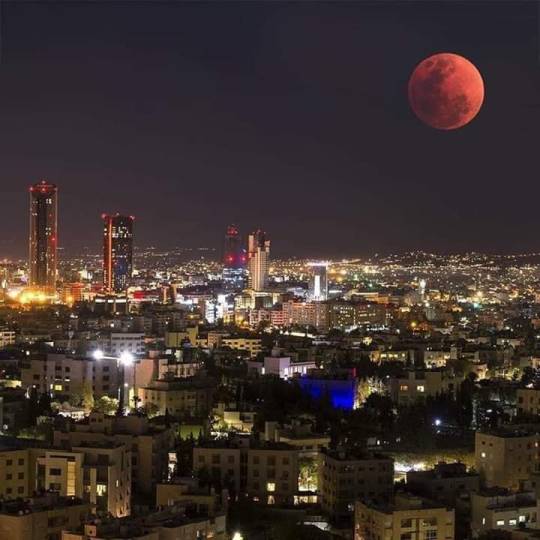



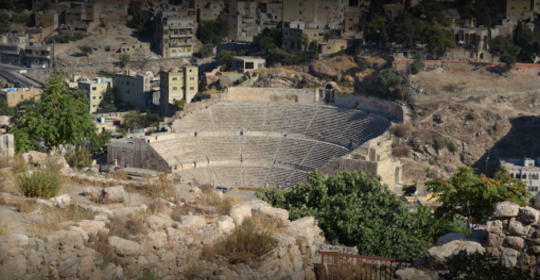
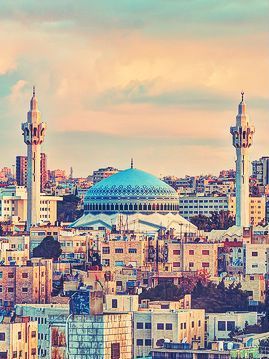



Amman City Tour
are you looking for an Amman city tour?
definitely, we provide these kinds of tour but before that, you should know what you gonna see.
let’s introduce brief details about what you will visit.
The Citadel
The citadel is a colorful site, rich in history and boasts a unique sunset overlooking the Roman Amphitheatre in Amman.
Amman Citadel stands as the guardian of ancient civilizations that left vestiges inside its 1,700-metre-long wall that dates to the Bronze Age.
Used as a rampart protecting the ancient capital of the Ammonites, Rabbath-Ammon — present-day Amman
The Jordan Tourism Board said Amman Citadel receives more than 125,000 visitors each year.
You cannot find a place with so many civilizations that left their marks in a single location. The citadel has this unique diversity that ranges from Assyrians to Babylonians, Persians, Greeks, and Romans, as well as the Umayyad and Ayyubid dynasties, a truly unique experience
The Roman Temple of Hercules that dates to the second century is one of the most popular attractions at the citadel. On display is a huge hand, which is believed to be from a 12-meter-high statue of Hercules.
The Roman Theatre
is the most impressive monument of old Philadelphia, as Amman was known when it was part of the Roman Decapolis, the cities network on the frontier of the Roman Empire in the southeastern Levant. According to an inscription, it was built during the era of the Antonine emperors, at the end of the 2nd century AD.
Its tiered, semicircular seating space, carved into the Jabal Al-Jofeh hill in three horizontal sections with a total of 44 rows can seat around 6,000 people. It faces north so that the audiences are protected from the sun. Social rank dictated the places for the audience. The urban poor, foreigners, slaves, and women were restricted to the upper section. The stage building, about 100 m wide, was probably three stories high. The wooden stage elevates 1.5 meters from the chorus performance space, the orchestra, which has a radius of 13 meters.
Today, the Roman Theatre is again in use for performances, concerts, and events. In addition, halls on both sides of the stage house two small heritage museums: The Folklore Museum and the Museum of Popular Traditions.
The King Abdullah Mosque in Amman – A Spectacular Jordanian Gem
No visit to Jordan is complete without a stop at the King Abdullah Mosque in Amman. By all accounts, the mosque is a prime example of Islamic architecture
The King Abdullah Mosque in Amman is instantly recognizable by its beautiful blue dome, under which as many as 3,000 devotees can gather for prayer. Anyone who spends even a minimal amount of time in the city will almost certainly see the mosque since it’s one of the most distinguishable buildings in the city.
Construction of the King Abdullah Mosque in Amman began in 1982 on the orders of the late King Hussein of Jordan. The mosque, which was to be a tribute to King Hussein’s grandfather, King Abdullah I of Jordan, was finally completed in 1986.
_____________________________________________________
Most people who visit Jordan do so because they have a fascination with history. They want to explore sites and places which have helped shape the world we live in today, and Jordan fits the bill perfectly, regardless of one’s age, gender, race or creed. Whether you want to visit areas mentioned in biblical scriptures, or whether you simply want to experience what it feels like to travel back in time, Jordan is a fantastic destination. Many people who have visited say that there is only one thing better in Jordan than the historical sites it has to offer, and that is the almost unimaginable hospitality of the locals.
________________________________________________-
Request your tour via the link below:
https://jordan-car-and-driver.com/quota-itinerary/
also, you can see our Planned tour via the link below:
https://jordan-car-and-driver.com/jordan-planned-tour/
0 notes
Photo

🇬🇧A face off in Roman ruins. Fun fact: Did you know that the capital of Jordan used to be known as Philadelphia when it was part of the Roman Empire? And Philadelphia USA is named after these beautiful ruins! Did @dx1games know that? 🇪🇸Frente a frente en las ruinas romanas. Dato curioso: ¿Sabías que la capital de Jordania solía ser conocida como Filadelfia cuando era parte del Imperio Romano? ¡Entonces Filadelfia EE.UU. lleva el nombre de estas hermosas ruinas! ¿@ Dx1games lo sabía? . Thank you @bejemannen for the collaboration. I took this photo in Egypt, and he edited the Pokémon and . #pokemon #pelopogo #pokemongo #gosnapshot #pokemongoar #pokemongoarplus #ポケモンgo #pogocollective #pokemongocontest #gosnapshot #vamosnianticlatam #vamosnianticmex #pokemongomexico #gosnapshotmx #ztdnews #gaming #jadecam #pogodailyar #pokecollections #pokemonphotography #pokemonfan #dugtriotop3 #ピカチュウ #ポケモン #ぽけもんgo #pkmnsnaps #AReikatje These guys support my dreams economically and they’ve inspired me to inspire them and many more. Huge thanks and be sure to check them out! . @larissarv @pepegmz @mollytaylor187 @pkmom71 @pokedexkylee @snap_them_all @theoneconspiracytheorist (at Amman Citadel) https://www.instagram.com/p/B40CRWBFXKn/?igshid=13o8kwmqvicx1
#pokemon#pelopogo#pokemongo#gosnapshot#pokemongoar#pokemongoarplus#ポケモンgo#pogocollective#pokemongocontest#vamosnianticlatam#vamosnianticmex#pokemongomexico#gosnapshotmx#ztdnews#gaming#jadecam#pogodailyar#pokecollections#pokemonphotography#pokemonfan#dugtriotop3#ピカチュウ#ポケモン#ぽけもんgo#pkmnsnaps#areikatje
0 notes
Text
Events 6.13
313 – The decisions of the Edict of Milan, signed by Constantine the Great and co-emperor Valerius Licinius, granting religious freedom throughout the Roman Empire, are published in Nicomedia.
1325 – Ibn Battuta begins his travels, leaving his home in Tangiers to travel to Mecca (gone 24 years).
1381 – In England, the Peasants' Revolt, led by Wat Tyler, comes to a head, as rebels set fire to the Savoy Palace.
1514 – Henry Grace à Dieu, at over 1,000 tons the largest warship in the world at this time, built at the new Woolwich Dockyard in England, is dedicated.
1525 – Martin Luther marries Katharina von Bora, against the celibacy rule decreed by the Roman Catholic Church for priests and nuns.
1625 – King Charles I of England marries Catholic princess Henrietta Maria of France and Navarre, at Canterbury.
1740 – Georgia provincial governor James Oglethorpe begins an unsuccessful attempt to take Spanish Florida during the Siege of St. Augustine.
1774 – Rhode Island becomes the first of Britain's North American colonies to ban the importation of slaves.
1777 – American Revolutionary War: Gilbert du Motier, Marquis de Lafayette lands near Charleston, South Carolina, in order to help the Continental Congress to train its army.
1805 – Lewis and Clark Expedition: Scouting ahead of the expedition, Meriwether Lewis and four companions sight the Great Falls of the Missouri River.
1855 – Twentieth opera of Giuseppe Verdi, Les vêpres siciliennes ("The Sicilian Vespers"), is premiered in Paris.
1881 – The USS Jeannette is crushed in an Arctic Ocean ice pack.
1886 – A fire devastates much of Vancouver, British Columbia.
1893 – Grover Cleveland notices a rough spot in his mouth and on July 1 undergoes secret, successful surgery to remove a large, cancerous portion of his jaw; the operation was not revealed to the public until 1917, nine years after the president's death.
1895 – Émile Levassor wins the world's first real automobile race. Levassor completed the 732-mile course, from Paris to Bordeaux and back, in just under 49 hours, at a then-impressive speed of about fifteen miles per hour (24 km/h).
1898 – Yukon Territory is formed, with Dawson chosen as its capital.
1917 – World War I: The deadliest German air raid on London of the war is carried out by Gotha G.IV bombers and results in 162 deaths, including 46 children, and 432 injuries.
1927 – Aviator Charles Lindbergh receives a ticker tape parade up 5th Avenue in New York City.
1944 – World War II: The Battle of Villers-Bocage: German tank ace Michael Wittmann ambushes elements of the British 7th Armoured Division, destroying up to fourteen tanks, fifteen personnel carriers and two anti-tank guns in a Tiger I tank.
1944 – World War II: German combat elements, reinforced by the 17th SS Panzergrenadier Division, launch a counterattack on American forces near Carentan.
1944 – World War II: Germany launches the first V1 Flying Bomb attack on England. Only four of the eleven bombs strike their targets.
1952 – Catalina affair: A Swedish Douglas DC-3 is shot down by a Soviet MiG-15 fighter.
1966 – The United States Supreme Court rules in Miranda v. Arizona that the police must inform suspects of their Fifth Amendment rights before questioning them (colloquially known as "Mirandizing").
1967 – U.S. President Lyndon B. Johnson nominates Solicitor-General Thurgood Marshall to become the first black justice on the U.S. Supreme Court.
1971 – Vietnam War: The New York Times begins publication of the Pentagon Papers.
1973 – In a game versus the Philadelphia Phillies at Veterans Stadium, Steve Garvey, Davey Lopes, Ron Cey and Bill Russell play together as an infield for the first time, going on to set the record of staying together for 8+1⁄2 years.
1977 – Convicted Martin Luther King Jr. assassin James Earl Ray is recaptured after escaping from prison three days before.
1977 – The Uphaar Cinema Fire took place at Green Park, Delhi, resulting in the deaths of 59 people and seriously injured 103 others.
1981 – At the Trooping the Colour ceremony in London, a teenager, Marcus Sarjeant, fires six blank shots at Queen Elizabeth II.
1982 – Fahd becomes King of Saudi Arabia upon the death of his brother, Khalid.
1982 – Battles of Tumbledown and Wireless Ridge, during the Falklands War.
1983 – Pioneer 10 becomes the first man-made object to leave the central Solar System when it passes beyond the orbit of Neptune.
1990 – First day of the June 1990 Mineriad in Romania. At least 240 strikers and students are arrested or killed in the chaos ensuing from the first post-Ceaușescu elections.
1994 – A jury in Anchorage, Alaska, blames recklessness by Exxon and Captain Joseph Hazelwood for the Exxon Valdez disaster, allowing victims of the oil spill to seek $15 billion in damages.
1996 – The Montana Freemen surrender after an 81-day standoff with FBI agents.
1996 – Garuda Indonesia flight 865 crashes during takeoff from Fukuoka Airport, killing three people and injuring 170.
1997 – A jury sentences Timothy McVeigh to death for his part in the 1995 Oklahoma City bombing.
1999 – BMW win 1999 24 Hours of Le Mans.
2000 – President Kim Dae-jung of South Korea meets Kim Jong-il, leader of North Korea, for the beginning of the first ever inter-Korea summit, in the northern capital of Pyongyang.
2000 – Italy pardons Mehmet Ali Ağca, the Turkish gunman who tried to kill Pope John Paul II in 1981.
2002 – The United States withdraws from the Anti-Ballistic Missile Treaty.
2005 – The jury acquits pop singer Michael Jackson of his charges for allegedly sexually molesting a child in 1993.
2007 – The Al Askari Mosque is bombed for a second time.
2010 – A capsule of the Japanese spacecraft Hayabusa, containing particles of the asteroid 25143 Itokawa, returns to Earth by landing in the Australian Outback.
2012 – A series of bombings across Iraq, including Baghdad, Hillah and Kirkuk, kills at least 93 people and wounds over 300 others.
2015 – A man opens fire at policemen outside the police headquarters in Dallas, Texas, while a bag containing a pipe bomb is also found. He was later shot dead by police.
2018 – Volkswagen is fined one billion euros over the emissions scandal.
2021 – A gas explosion in Zhangwan district of Shiyan city, in Hubei province of China kills at least 12 people and wounds over 138 others.
0 notes
Text
May History
May 29, 1453 - The city of Constantinople was captured by the Turks, who renamed it Istanbul. This marked the end of the Byzantine Empire as Istanbul became the capital of the Ottoman Empire.
May 29, 1660 - The English monarchy was restored with Charles II on the throne after several years of a Commonwealth under Lord Protector Oliver Cromwell.
May 29, 1787 - At the Constitutional Convention in Philadelphia the Virginia Plan was proposed calling for a new government consisting of a legislature with two houses, an executive chosen by the legislature and a judicial branch.
May 29, 1865 - Following the American Civil War, President Andrew Johnson issued a proclamation granting general amnesty to Confederates. The amnesty excluded high ranking Confederates and large property owners, who had to apply individually to the President for a pardon. Following an oath of allegiance, all former property rights, except slaves, were returned to the former owners.
Birthday - American revolutionary leader Patrick Henry (1736-1799) was born in Studley, Virginia. He is best remembered for his speech in 1775 declaring: "I know not what course others may take, but as for me, give me liberty or give me death."
Birthday - German historian Oswald Spengler (1880-1936) was born in Blankenburg-am-Harz, Germany. He authored the influential book The Decline of the West which argued that civilizations rise and fall in regular cycles.
Birthday - John Fitzgerald Kennedy (1917-1963) the 35th U.S. President was born in Brookline, Massachusetts. He was the youngest man ever elected to the presidency and the first Roman Catholic. He was assassinated in Dallas, November 22, 1963, the fourth President to killed by an assassin.
0 notes
Text
ico compliance

The Introduction: First sale of stock: IPOs have an old and fascinating start. An IPO is an idea of welcoming open venture for an organization when it dispatches open issues. This obviously makes the organization, out of the limits of being only a "restricted" organization and opens the entryways of proprietorship and benefit share for individuals who are not "effectively" associated with the activities of the organization. These "investors" are for the most part no leaders and are only the value holding people or organizations. They are neither utilized nor supported by the organization. They could get profited by verifying the offers for more and could sit tight for the exponential development in the expense of offers, it could, in any case, go in a contrary heading as well if the counts don't go as per the arrangement anticipated. ico compliance
Introductory COIN OFFERING: ICO, be that as it may, is a greater amount of a propelled adaptation of an IPO, a few glitches are settled and expelled, the limits of functional and materialistic items and arranging have been survived and extends presented have been engaged upon, in an ICO. It is tied in with "crowdfunding", centering towards "cryptographic money", which is utilized as a capital for new companies. These new companies are for the most part possessed and worked by the youths, who have new and creative thoughts for the business. Previously or after the "tokens" become "coin" and gone to the trade, a great deal of techniques must be dealt with. Individuals who purchase tokens could sell the stakes, whenever they wish to, even before the "trade" stage comes. After the "token" comes to trade and turns into a "coin", it's free from the introducer and totally goes to the "request and supply" crazy ride".
History: The Similarities and Differences.: there are a few similitudes, yet huge contrasts as well, with regards to correlation of IPO and ICO. Recorded proof could be broke down and considered for a superior understanding of the relativity, prerequisite, and life span of the common sense of both, in the present financial and specialized world.
First sale of stock:
The main IPO was presented amid the rule of Roman Republic (509 BC - 27BC) when Publicani, those were the autonomous lawful bodies, whose possession was circulated into Partes (shares). These Partes were obviously sold to open financial specialists and it was an open market, with fluctuating costs of Partes. There used to be onlookers and it isn't vastly different than the present situation of offer markets we can see nowadays. The presence and significance of Publicani were lost after the Roman Empire ascended in 27 BC thus had the most seasoned stock trade existed. ico aml
The primary "present day IPO" happened in 1602, when VOC (Dutch East India Company), opened an open issue for the organization so as to raise reserves. The Dutch East India Company was raising assets for the extension of the overall business and the foundation of states in various pieces of the world. The open was made a piece of the undertaking and was offered benefits with the development of the organization. VOC turned into the main organization to acquaint offers and bonds with the General open. So VOC authoritatively could be attributed as the first historically speaking organization to be recorded on an official stock trade.
Amid about a similar time span, in the United States, the primary IPO was the open offering by Bank of North America. This private bank was received by The Confederation Congress, in may 1781, and was opened in Philadelphia, on seventh January 1782. The principal IPO issued by Bank Of North America was issued in 1783.
Starting Coin Offering:
Mastercoin started the primary token deal or "Introductory coin offering" in July 2013. It began the pattern of tolerating legitimate delicate (govt. endorsed money) or replaceable coins so as to purchase a token. ETHEREUM fund-raised in 2014, by a token deal, at a gathering of 3700 Bitcoin in the initial 12 hours, which was comparable to $2.3 million around then.Karmacoin started a token deal in April 2014, for Karmashare venture.
The pattern, be that as it may, began in the year 2017, when ICOs and token deals ended up famous and there were critical numbers for the postings, commercials and token deals till July 2017.
Presently since it is an as of late presented thing and has not been trailed by some (significantly), it doesn't convey an exceptionally long history to be told about. In any case, considering the ubiquity and development this marvel has picked up in last not exactly 10 years, has made it an unavoidable chain of occasions. crypto bank account
It has recently pulled in the thought and enthusiasm of not just the young with creative thoughts and startup designs yet in addition built up names and fruitful business around the globe. A standout amongst the most pertinent essential behind propelling a token deal, or offering a coin is, the way you back it up with the future arrangement about it, and how you speak to it with the vision, which could be shared and felt by the general gathering of people.
As much one could sum up the idea driving the coin and make it associated with the most extreme number of "sorts" of individuals, more is the likelihood of its, contacting the hard top sooner. (Hard top is the most extreme number of tokens to be conveyed amid an ICO). Promoting contrasts, customary similitudes:
Albeit both of these are diverse as far as the business age, the open support and the plausible "sorts" of individuals inspired by both of them separately, they have numerous conventional similitudes.
1) 'KIND' of individuals, who are financially dynamic, exceptional available patterns and are prepared to be profited on the expense of hazard inclusion, are the "expert intrigued" individuals who get into IPOs or ICOs.
2) Open for everybody, both of these present and make no confinements by any stretch of the imagination, with regards to venture, for individuals. Initial public offerings, be that as it may, are feeling the loss of the influence those could be given in ICOs, for abroad clients. ICO legal advice
3) An 'Outline' in an IPO, which portrays the shareholding, common store estimate, organization's arrangements and IPOs vision initially, turns into a 'WHITE PAPER" in an ICO, which depicts the ICO's particulars, the one of a kind selling purposes of the token, the declarations and introductory plans of the ICO, and the progressed guide for the entire ICO period.
4) Shares or bonds could be purchased or sold, whenever. There is no time/individual bound action which makes it a nontransferrable element. All through the IPO, an individual could get it from some other individual, (if not straightforwardly from the introducer). This has been a training in both, IPO and ICO separately. As far as benefit, individuals do inside selling/purchasing.
5) An IPO regularly has been presented by an effectively settled organization or firm. It by and large doesn't get associated or identified with a person. Despite what might be expected, an ICO gets presented by a sole dependable individual or person. The showcasing, trust building and vision sharing happen at the same time, while the ICO gets propelled and the ICO time frame goes on.
6) ICOs and IPOs are diverse as far as how they present themselves before the financial specialist network. An IPO needs to assemble the trust about the item and related plans must be imparted to a long haul security factor. Initial public offering is a totally controlled wonder and the introducer stays in charge of the expense and cost of the offer/bond until the end of time. Despite what might be expected, in an ICO, when the "token" turns into a "coin", the introducer's control is viewed as done and the cost changes with the "request and supply" essentials. shares tokenization
7) An IPO is about another undertaking/plan or another dare to be begun that has a foresighted execution methodology and estimations about upsides and downsides, on the off chance that, at that point else contemplations and most dire outcome imaginable safeguard plans for everything (nearly). Nothing can, be that as it may, anticipate the market sending of an IPO, and IPOs do flop as well. An ICO be that as it may, is simply to gather the capital for some different business, which has nothing to do with the reason for the coin(mostly) and is utilized just to produce the required store for a business. The introducer could be a youth, a tech nerd or a not all that known software engineer. When the token turns into a coin, even the financial specialists are not quick to tail him for future, as they have just been profited all through the ICO time frame and even a short time later. THE DECISION IS YOURS:
An ICO is the dynamic period's decision, things go quick, no enormous names, no brand association and no long haul venture plans and similarly anticipated returns. The alternative to picked an ICO surely is fast advantage fulfilling, if you are knowledgeable with the nature of a token's projections and you could be sure (even the smallest ) about the eventual fate of the token's fate in the market. Just by giving some additional opportunity to an alleged "nerd" adjacent, you could become familiar with about it. At that point you could begin re-characterizing your fortune. STO legal advice
An IPO is a way conventional method for "bringing organic products" from another person's tree, while you have been watering it when it was a sapling. It is similarly hazardous, dubious and even the projections and forecasts couldn't be characterized well. However it has been a fruitful method for making several individuals, tycoons. It is, in any case, very moderate of a procedure and that "feeling of wonder" stays for an exceptionally significant lot of time, contrasted with that in an ICO.
One needs to choose his own about where to go. Considering everything, considering the way that individuals are as yet putting resources into both. They are getting more extravagant. They are imparting their examples of overcoming adversity to you. Which way might you want to go now?
ICO (starting coin offering) has been an exceptionally decent approach to increase a few assets in a significant snappy and dynamic way. Individuals, all around help some tech nerds in their undertaking to raise a few assets by ICO and every one of them get profited. A success win for all. an IPO (first sale of stock) had been a more established form of the equivalent, yet was not open for all, and have been managed by offer trades and different bodies. It has its own breaking points and supervisions. Visit our website for more information here==>>https://www.tokenomics.ch/
0 notes
Quote
Welcome to the sad, sorrowful truth of Gem's life and Philadelphia's Underworld, 1985...in 'PUNKS' the novel...
“NEXT STOP….ALLEGHENY….ALLEGHENY…NEXT STOP!!” ……the garbled, scratchy early morning voice of the engineer bellows through the gnarled, subway car speaker. Gem springs up from her comfortable quiescence, nudging me along. “C’mon cutie, our journey continues.” Wrapping my arms comfortably around her svelte waist, I sandwich her between the pitted, rusty subway car stanchion and my body’s full weight. “Mmmmmm, now this is why I still like to nuzzle,” Gem purrs.
The incessant brake squealing makes it hard to even think and after a few quick lurches and jerks occur before our car comes to rest at the stations platform, the doors barely release, allowing for our escape before hurriedly making our way through the turnstiles. It becomes an obstacle course navigating the steps again with an overabundance of exhausted souls using them as beds and a gauntlet of spent hypodermics to circumvent. “Watch out for those needles Robbs, they seem to be everywhere,” Gem cautiously whispers.
A very young punk with golden, warrior spikes lies in a comatose state at the top of the graffiti strewn vestibule. Newspapers, empty coffee cups, and food wrappers have piled up around him but he’s too gone to notice. The smell of spray paint lingers and there are traces of silver around his nostrils and mouth. He’s been huffing and from the looks of the two shiners under his eyes, someone decked him pretty hard before the inhalants took him out even further.
“Is he even making any sounds, Robbs?” Gem inquires sheepishly before I get close enough to hear his short, labored breaths. “He’s alive babe, but he’s hurtin’ pretty badly.” With Gem’s help, I manage to lug him up the steps and out into the crisp, autumn air. He’s still pretty shot in the ass to help very much but at least he’s not lying in a puddle of piss anymore. Our young junkie is a microcosm of the bigger picture plaguing the Kensington and Allegheny section of Philadelphia. Once a large, blue collar manufacturing region, the only industries growing amongst the dilapidated factories and tattered, brick rowhomes were drugs and prostitution. Surveying the landscape in front of us was a harrowing experience, to say the least. On every corner, in every alley, down every sidewalk were despondency, destruction and hopelessness. The fall foliage, blue skies and regal sunlight from above can do nothing to liven up the misery on display here.
Even at this early hour of Saturday morning, the drug and skin trade was in full effect further away from Broad and West Allegheny. Dealers and pimps peddle their wares to the suburban “Masters of the Universe,” who travel far away from their lush lawns, pedigreed wives or girlfriends residing in gated communities, to sample the pleasures of pure decadence behind the doors of filth ridden tenements overrun by rats and littered with soiled cots stained by numerous body fluids.
In the hazy lust for the pleasures of the flesh and the warping of your mind, cleanliness and decorum seem to fall easily by the wayside in the lives of the so-called powerful and entitled, although the preppie bastards in their ‘Bimmers’, Audi’s and Benz’s are arrogant enough to think they hold some semblance of clout here until the bullets start to fly, or when the Brody’s finally decide to raid the Avenue, thus reducing the trust fund, jetsetters to literally wail like infants for forgiveness in their presence. In the rare instances that either happen, it’s an entertaining, joyous sight to behold watching the upper crust grovel to whom they on any other day deem as the bottom feeders of society.
Extracting the thermos of coffee from my backpack, I get a couple of muffins out of the pouch, handing one of them to Gem as we both lean on a freshly stripped, new, red Cadillac Eldorado convertible that was torched and left in a overgrown, debris filled lot to die its lonely death amongst the ruins of capitalism gone awry. Gem shakes her head, tossing her hair from side to side, hoists the thermos cup and offers a toast. “Welcome to the American underworld, baby boy, in its entire rancid, horrific splendor. You’re witnessing the fall of a modern day Roman Empire and punks like us have the soundtrack for its destruction.”
Taking residence on the Cadillac’s torn up, burnt frame; I try to absorb the amassing, broad daylight chaos which reminds me so much of the stories written about the South Bronx when I was still in New York. “Gem, is this where your family lived before you moved up by the Yamaguchi’s?”
“This is it, Robbs, the junkie proletariats’ Rodeo Drive. Take a walk with me. It’s a number of blocks to East Allegheny, the alphabet blocks and the El and yes, it’s quite depressing but it’ll give you a glimpse of how your girl grew up and where my evil father earned his street reputation.” A beater car full of little shit punks rolls by blaring The Clash’s, ‘Working for the Clampdown,” as they wail on the horn and wave to Gem. It’s another place where I quickly find out in our travels that the presence of Gemma Stinson still holds a mighty amount of sway.
Sharing another muffin, I ask Gem about how they finally got Lena away from the total street life existence. “Icy got really shook up when Trix murdered Stace. Hell, how many young girls do you know who’ve watched three of their girlfriends die within a year or so of one another?”
“Not too many, love.”
“Mister Yamaguchi found her a good paying job at the Budd Company and in return, she promised him that she’d at least finish high school to earn her diploma. Listen Robbs, ‘Icy’ still has a lot of her street ways, as do I.
I’ve tried to take mine down a notch but it’s not always that easy because the lure of the street is very tempting……it can be very hard to turn away from.
You witnessed how fast Lena can become a handful of trouble for someone by the way she acted in Fairmount just recently. She would’ve torn those skinheads to shreds if they’d laid a hand on you and even Yuka got a taste of what street life was like by hanging around with us in high school. Her fists are quick, Robbs. I’ve seen her deck a few people really hard.
Even you have a street brawler mentality, mixed in with some pretty lightning quick fist work. It’s just wicked to watch you have a go at people, but admittedly I’m much happier when we don’t have to fight anyone.”
“No argument there, Gem. Peaceful is much better but it’s nice to know we won’t take any wankers shit either.”
We travel further through the chaos and as dangerous as this part of town can be, there is a weird sense of security being around Gem here. There’s an odd acquiescence taking place in the bowels of Allegheny. Wherever Gem seems to travel here this morning, there is almost deference to royalty approaching and she becomes more annoyed by the attention. “They know who I am, Robbs. No harm will probably ever come to me up here because of who my asshole father was. Even in fuckin’ death, he holds a level of fear over people.
Only after he was killed did people in the K & A begin to hear the animal that he was at home. They already knew the brutal enforcer he was on the street….the stone cold killer who could charm you with his handsome smile, right before he beat you within an inch of your life with his iron fists, just because you owed money to the Italian or Irish mobsters who retained his services.
Even my mother was feared by most when she was younger and not all strung out. If my father ever did get himself caught up in shit from time to time, she’d think nothing of putting a gun to your neck or in your mouth. It really was a demented way to live and makes you wonder why in the hell they’d ever bring a child into this kind of world.”
Another group of middle age roughs step aside when Gem and I approach, bowing their heads either out of a shallow respect or the trepidation that still apparently exists when a Stinson travels through these broken streets filled with one residence more neglected than the other. She smiles ever so slightly but grunts mildly in disgust. “God, it’s so fucking humiliating that the bastard still holds that kind of sway down here.”
Remaining silent, I can’t imagine the burden it must be for Gemma to return to these badlands of pure hell. Whereas she is revered, loved, respected and feared ONLY by those who are up to no good in our punk enclave of South Street and its environs, you can bear witness to the pain it causes her to see the denizens of her old place of birth still reacting this way. “Let’s backtrack and pick up the pace, Robbs,” she says as the SEPTA Elevated roars above us while some street urchins add their tags to the volumes already existing on the steel girders below. Retracing our steps through the human and bricks and mortar rubble that have become North Philadelphia we eventually pass the entrance for the Broad Street Line. “We’ll be back soon enough to take the subway, Robbs but there’s one more place I need to see before I depart this sorrowful landscape. Hang tight, we’re almost where I want to take you,” she sighs heavily, lamentably.
Turning onto North 15th Street, Gem slows the pace down to a crawl, eventually pointing across the street to a derelict row house, covered by overgrown shrubs, thick, weed trees and lathered with crude graffiti. The faded words “DEMON” and “RAPIST” are splattered across the splintered, wooden front door. Gem asks me for a Red; I comply quickly, blazing it up before she takes a long drag and sighs heavily. “There it is, Robbs…3250, North 15th…..where my life of hell with Allan and Gabriella Stinson began.”
“Gem, you really don’t have to do…..” but Gem admonishes me with a mild rebuke. “Yes, I do have to face my demons, Robbs. That’s why I needed you here by my side….the only person who can help me do this.”
Calmly, I take hold of her hand, lifting it towards my lips. “I’m here for you, no matter what, Gem.”
“This is where Allan Stinson, a machinist by trade, coming from the hard working stock of German, Dutch, Scotch, Irish and the Cherokee tribe brought his bride, Gabriella, a tall, slender, lovely woman of Italian, French, Icelandic and Russian lineage to live and die; and on the in between years, they decided to copulate and bring an unwanted little girl into their boozer, junkie world.
I can’t find it in my heart to forgive them for what they did to me since they seldom tried to love me, even when times weren’t so bad for them. They were too worried about being stone cold junkies or drunks. My father was too worried about being the enforcer who’d crush skulls in for non-payments on ‘debts’. They were too worried about partying their asses off and leaving their daughter to fend for herself. They laughed when I was beaten, they laughed when I was a young girl and they spiked my orange juice with vodka to get me drunk…. The list of their evil goes on and on, Robbs.”
A stiff breeze suddenly whisks through the street, sending debris swirling into the air like dry, fallen, autumn leaves. Gem swings her hair to and fro while tenaciously approaching the house through increasingly ferocious, heavy winds, before suddenly stopping, balling up her fists so violently that she doesn’t even notice one of her talon-like nails has dug into her palm, sending slow drips of blood to the pavement. The winds die for a moment but pick up stronger than before, a minute or so later and the superlative beauty of the sun has increasingly disappeared, only to be replaced by menacing, gray clouds, making the fetid landscape of this part of town even more ominous.
Gem’s eyes darken in a way that I’ve never seen before, as if summoning up forces from above to do her bidding against this place of evil. “Hold my hand, Robbs…no matter what I say, don’t stop holding my hand.”
My grip on her is viselike. “I’m not going anywhere, so say what you have to, Gem,’ who glares at the house again while the wind whips her auburn hair in all directions, making it look flame-like. A wicked smile crosses her face and she emits a low growl. “You know that I’m back again, after all this time, don’t you, Al and Gaby? Did you think you could keep me away forever? Did you think people wouldn’t know what you two assholes did to me?
I see your shithole of depravity got tagged for the whole neighborhood to see. Icy and Stace said they were gonna’ do it, and I’m glad they did. They should have included MURDERERS, because you broke Uncle Ronnie’s spirit, hastening his painful death and God knows how many people you sent to their untimely deaths by your other monstrous actions.”
The winds begin driving against us even harder but Gem remains undeterred, letting loose a surge of venom against the howling gusts. “You two pieces of shit can send all these torrents of wind at me, trying to drown out my voice but I WILL say what I have to! I HATE YOU FOR WHAT YOU DID TO ME….FOR WHAT YOU LET BE DONE TO ME BY OTHERS…ALL I WANTED WAS LOVE….ALL THAT ANY LITTLE GIRL WANTS FROM HER MOM AND DAD!!!
She starts to whimper as tears hit the ground but the ferocity of Gem returns in spades. “YOU both hurt me beyond belief but now I will be strong in your presence, because this house of hell represents the two of you!! DEAD and BURIED ….it’s where you belong so you can’t hurt anyone else! I just want you to know that I’ve found LOVE and HE’S WITH ME RIGHT NOW…he’s brought a smile to my face ….and a song to my heart….AND BECAUSE OF HIM…YOU WILL NEVER HURT ME AGAIN!!!!
NEVER!!!! NEVER!!! Never….never….” Her grip lightens up, as light sobs have joined Gem’s fury. Picking up a loose brick from the ground, it’s heaved through the only glass pane left on the derelict structure. “FUCK YOU…GABY AND AL!!!! NOW, YOU’RE TRULY DEAD TO ME!!” she bellows as the glass explodes, sending shards flying violently in all directions. The wind still whips feverishly around us while Gem pulls me closer; with tears falling like rain, she locks stares with me. “I…. love you so much, Robbs. Kiss me….just kiss me…I am madly in love with you….kiss me and tell me it will all be all right…”
An excerpt from Rich Cucarese’s (that’s me!) upcoming, fictional novel, ‘PUNKS’, Chapter 18, ‘The Underworld’.....
youtube
“What are we gonna’ do now?”.....The Clash, ‘Working for the Clampdown’

huffing....
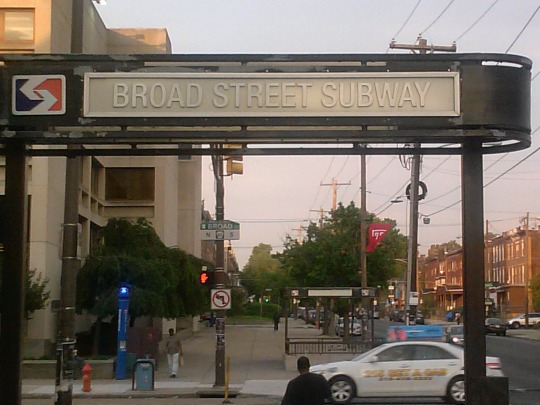
Broad Street and Allegheny Avenue, coming up from the Broad Street Line...
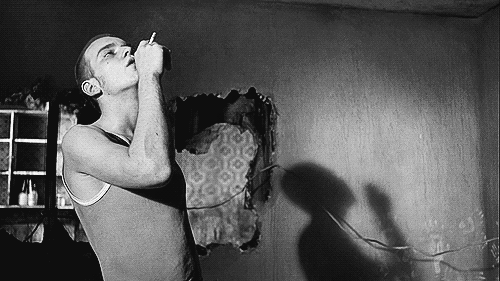
Trainspotting...could’ve been shot in Kensington and Allegheny at any time in the past thirty years....

The needle and the damage done....

Gemma ‘Swan’ Stinson’s old stomping grounds....

North 15th and Allegheny....where the rough and tumble, sorrowful childhood existence of Gemma began....

Allegheny Avenue, Philadelphia....Gemma’s old neighborhood of tough times and sorrows...Sadly,not much has changed in thirty years....
#gopunksphilly#philly punk#philadelphia#the badlands#'punks' the novel#the clash#poverty#desolation#drug addiction#heroin#child abuse#rape
2 notes
·
View notes